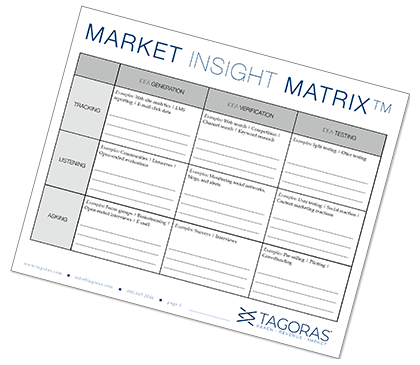Market Insight Matrix™

The Market Insight MatrixTM can help your organization manage a rigorous and practical market assessment process, through three stages and three categories of activities, to identify learning products that will address market needs.
3 Stages of Market Assessment
We see three stages in market assessment:
- Idea generation
The higher the quality of the ideas you come up with initially, the easier and more effective the subsequent parts of the market assessment process will be. You want diverse input at this stage. Don’t rely only on the input of your education committee. You also need input from staff and volunteers, important customers, and influencers in your market. - Idea verification
In our experience, many organizations effectively stop at the idea generation stage. They come up with a few good ideas, prioritize one or two of them—often based on the thinking of a small number of people in the organization—and then begin building a product. A better approach is to take the ideas generated in stage 1 and verify them by looking at what Web searches, customers’ and prospects’ discussions in social media, and surveys and polls can tell you. - Idea testing
To test the idea, put the concept—or even a version of the product—into the market place and see if you can get people to take action. Will they sign up for future notifications via a landing page? Can you pre-sell the product and thereby ensure purchases from the get-go?
3 Categories of Market Assessment Activities
The stages are one key part of the process. The next part is the types of activities you should engage in across these stages. These fall into three main categories:
- Tracking
Tracking focuses primarily on historical, quantitative data. What can you tell—based on a variety of tools like Google Analytics, Google Trends, and data from your e-commerce and learning management systems—about the behavior of your members and customers in the recent past? What content has been of interest? Where have they found it? - Listening
Listening focuses on observing what your members and customers are saying and doing. What are they saying as they interact with each other, your organization and its offerings, even your competitors and their offerings? You can find out by monitoring social media, conducting user testing, or mining evaluations. - Asking
Asking involves you engaging directly with stakeholders and requesting their input on specific questions. This is the path of traditional tools like surveys and focus groups but also includes activities like pre-selling and crowdfunding.
The Market Insight Matrix
Combine the stages and the activity categories, and we get the Market Insight Matrix.
Its goal is to ensure you have a process that generates diverse input and doesn’t rely too heavily on any one source.
The stages, combined with the activities, take you through a logical process that helps you be rigorous at each stage and filter down to the best options.
The PDF resource includes the Market Insight Matrix (where you can make note of what you’re doing in each stage and with each activity category) and suggestions for tools that might help you with your tracking, listening, and asking activities.